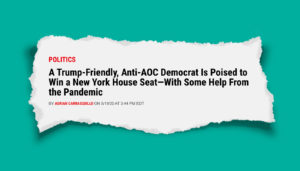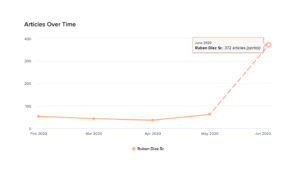How Bronx United Broke Through in a Crowded Media Environment — and Changed the Trajectory of a Critical Primary Election in NYC
When Precision took on Bronx United, we faced a tough challenge: a Trump-friendly, anti-choice Democrat, Ruben Diaz Sr., was poised to win an open congressional seat in the heart of New York City.
In a district called an “Obama oasis” — one that borders Rep. Alexandria Ocasio-Cortez’s — this should have been alarming. However, few were taking note of Diaz Sr.’s momentum in the NY-15 race in the midst of the COVID-19 pandemic and other high-profile primaries in the New York media market.
Working with Bronx United, an unaligned Independent Expenditure, our mission was to highlight how Diaz Sr. was clearly out-of-step with progressive values, thereby creating space for another candidate to build momentum. Over the course of just a few months, the team brought attention to this important but under-the-radar congressional primary and elevated it into a national conversation that ultimately helped defeat Diaz Sr.
We sat down with the team-lead to talk about Precision’s work with Bronx United and the behind-the-scenes work that led to a winning strategy in NY-15.
Q: Tell us about Bronx United and why this work was necessary.
A: The NY-15 race was unique; it was an open seat with a lot of candidates running to replace a longtime incumbent. The broad field and low-profile nature of the primary allowed a candidate like Ruben Diaz Sr. — who has longstanding ties to the district — to rise to the forefront and stand a very real chance of winning.
With that being said, if you look at Diaz Sr.’s history, he’s unqualified to represent that community. Diaz Sr. has a history of opposing issues like same-sex marriage and a woman’s right to choose. Moreover, he’s also made homophobic remarks and stated he’s considering voting for President Trump in November. In a district where President Obama took nearly 97% of the vote in 2012, those views are not representative of NY-15’s constituents. That’s why Bronx United stepped in.
Our strategy was to shine a light on where Ruben Diaz Sr. stood on these issues and to get as many national and New York City eyes on the race as possible to galvanize voters. The more voters learned about Diaz Sr., the clearer it became that this was not the kind of politician they wanted in Congress.
Q: How did you break through in a crowded media environment to build a narrative surrounding the NY-15 race and define Ruben Diaz Sr.?
A: “Crowded” media environment is almost an understatement. Our work primarily took place in May and June, and if you think about everything that was going on during that time, from the ongoing pandemic to social justice protests, there were just so many important issues being discussed around the country.
We were able to break through by strategically leveraging our media relationships and tactical wherewithal. Precision has deep roots in both NY and DC, and we used that to build an earned media campaign that successfully defined this candidate and race both locally and nationally. That strategy hinged on placing a high-impact story in a national publication, and with some tailored outreach, we successfully landed that story in Newsweek. Our pitch leaned on a sense of urgency, as the primary was quickly approaching.
Key to our strategy was also using Diaz Sr.’s own words to build the narrative. We weren’t constructing anything that wasn’t true — he said the quotes, he stood by his beliefs. We framed and packaged Diaz Sr. so the media and other influencers could better understand why he was wrong for the district.

Q: How did you ensure surround sound and keep the momentum going in the weeks leading up to the New York primary?
A: After the Newsweek story was published, we launched a 360-degree earned media strategy to have maximum impact. In particular, we targeted reporters who have covered New York and DC in the past. It was important that we first reached journalists who really understand those markets and the politics within them so they could help tell the story to those who are less familiar. We purposefully pursued a mix of coverage and profile pieces on Diaz Sr. that we knew would be unflattering given his record on key issues, including national political stories, coverage in LGBTQ focused outlets, stories from DC congressional reporters, local NYC media, and more.
We also launched a robust rapid response operation to keep content flowing about Diaz Sr. in the final weeks leading up to the election. The whole team was driven to be successful and our commitment to getting the story out was clear: once we were on board, articles about Diaz Sr. skyrocketed from under 100 per month to nearly 400 in June alone, just ahead of voting day. The increase in awareness about Diaz Sr. and the race overall no doubt paved the way for his loss.

Q: What does your experience with the IE in NY15 say about the future of politics and campaigning in New York City and elsewhere?
A: My biggest takeaway is that it’s still possible to break through in a crowded media environment with a proactive, on-message campaign that releases a steady stream of news and hooks to keep reporters interested. The NY-15 race — along with other primaries this cycle in New York City — also shows that there is a new generation of politicians coming into their own here in New York. It’s a really exciting time to be part of that.